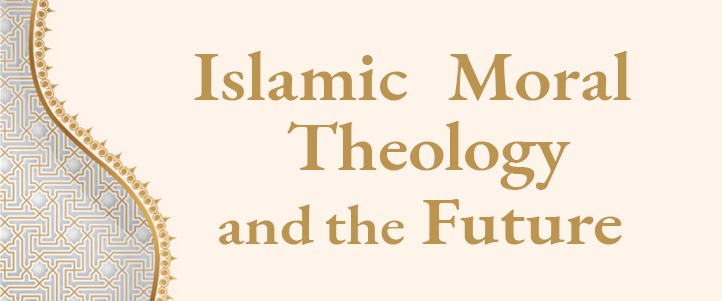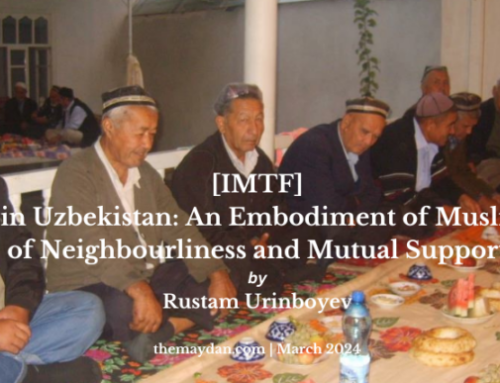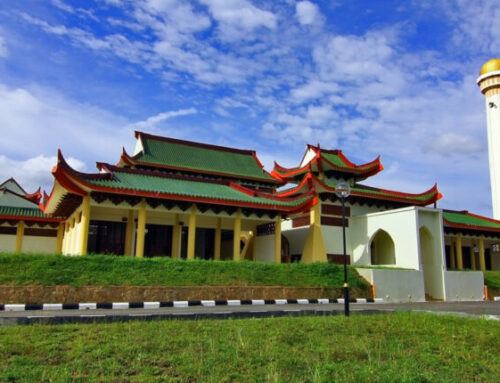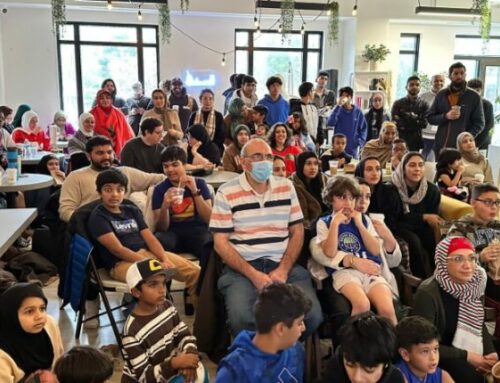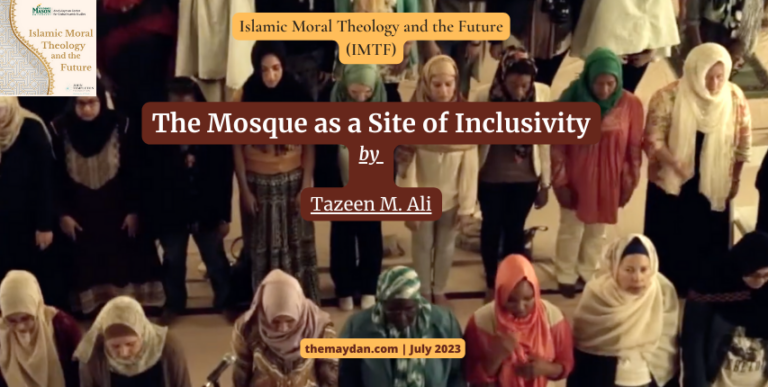
The Mosque as a Site of Inclusivity
Since the earliest days of Islamic history, Muslims have deliberated over the structure and purpose of the mosque. The Arabic term for mosque, masjid, derives from the Qur’an and translates simply as a place of prostration. In Muslim tradition, as far as prayer is concerned, the Prophet Muhammad is reported to have said that all the earth is a masjid where believers are free to offer their ritual acts of worship. But even in seventh century Arabia, mosques were more than just sites of worship. Indeed, Muhammad’s house in Medina, widely considered as the first mosque, was not only a site of individual and communal prayer for the first Muslims, but also a place of religious instruction and social gathering. Today, congregations such as the Women’s Mosque of America, a multiracial and multiethnic all-women’s congregation in Los Angeles, make the case that the mosque should not only be a place for prayer, but also a space to inculcate Muslims with the values of gender, racial, and ethnic inclusivity.
I analyze the Women’s Mosque of America (WMA) and the ways that it empowers American Muslim women to cultivate Islamic authority and redefines what a mosque should look like, in my new book, The Women’s Mosque of America: Authority and Community in US Islam (NYU Press, 2022). Founded in 2015, the WMA is a non-profit institution for Muslim women and their interfaith allies, wherein women perform the call to prayer, deliver the sermons, and lead ritual prayer at monthly Jummah, Friday prayer, services. As I argue in my book, the WMA emerges in response to a history of women’s marginalization across US mosques, in which women are often relegated to inferior quarters in comparison to their male counterparts. In women’s sections across mosques in the US, it is difficult if not impossible for Muslim women to hear and therefore engage with the Friday khutbah (sermon) and focus on their prayers. The WMA offers a corrective to this marginalization by operating as an exclusive mosque for women, where they need not compete for suitable prayer space within the mosque, access to the khutbah, or for leadership roles with men and can become empowered in their faith in the process.
Today, congregations such as the Women’s Mosque of America, a multiracial and multiethnic all-women’s congregation in Los Angeles, make the case that the mosque should not only be a place for prayer, but also a space to inculcate Muslims with the values of gender, racial, and ethnic inclusivity.
Some of the WMA’s critics have argued that in creating an exclusive mosque for women, it risks further fragmenting the Muslim ummah, or community. However, WMA organizers do not envisage this all-female space as in competition with conventional mosques. They characterize the WMA as a complementary space where its congregants can gain the confidence and skills necessary to adopt leadership roles in their own respective community mosques and foster social changes therein. What then, are these changes within US mosques that the WMA and congregations like it, implicitly advocate for? My research highlights that gender inclusivity, and advocating for women’s public roles within the mosque, is but one part of the larger project of the WMA. I argue that this singular community offers us insights into emerging conceptions of what American mosques could – and should – look like, according to Muslims who treat social justice and inclusivity across gendered, racialized, and sectarian lines, as Islamic virtues.
An examination of the WMA’s Friday khutbas delivered monthly by different lay Muslim khatibas (women preachers), offers us a window into how these virtues of social justice and inclusivity are promoted on both the individual and communal levels.
An examination of the WMA’s Friday khuṭbas delivered monthly by different lay Muslim khaṭības (women preachers), offers us a window into how these virtues of social justice and inclusivity are promoted on both the individual and communal levels. The American Muslim women in this congregation form an interpretive community in which they seek to cultivate these virtues within themselves and among fellow Muslims. Khaṭības approach issues such as sexual violence, anti-Blackness, and intra-Muslim racism through the lens of scripture – namely the Qur’an, but also Hadith, the sayings of the Prophet Muhammad – as social issues that require communal attention. Referencing specific Qur’anic verses in their calls to address these issues, these American Muslim women posit that seeking solutions to such issues should be understood as Islamic moral imperatives. Moreover, in their engagement with the Qur’an, they emphasize their identities as everyday Muslim women who are not trained Islamic scholars, to encourage congregants that they too, should read scriptures for themselves to be able to relate Islamic teachings to the contemporary US social issues that are important to them. In the process, they also encourage congregants to cultivate a personal, individual relationship to the text and to God, which also emerges as an important religious value within this community of women.
Sexual violence is the subject of one of the earliest khuṭbas in the WMA’s tenure and among the congregants I spoke to over the course of field interviews, one of the most powerful. In this khuṭba, titled “Sexual Violence and the Necessity of Compassion and Justice,” the khaṭība, Sumaya Abubaker speaks to the congregation as a survivor of multiple assaults, including at the hands of a religious leader at a mosque. Several congregants identified Abubaker’s khutbah as among the most powerful they had ever heard at the WMA and in their other mosque-going experiences. The khuṭba was premised upon the Qur’anic concepts of compassion and justice. Abubaker calls for Muslim communities to treat victims of sexual violence with compassion and seek justice by bringing perpetrators of violence to account. In particular, she critiques the broader culture of silence around gender-based violence in Muslim communities and invokes Qur’anic verse 4:135:
You who believe, uphold justice and bear witness to God, even if it is against yourselves, your parents, or your close relatives. Whether the person is rich or poor, God can best take care of both. Refrain from following your own desire, so that you can act justly—if you distort or neglect justice, God is fully aware of what you do.
Abubaker uses the above verse, as I analyze in, The Women’s Mosque of America: Authority and Community in US Islam (Ali 2022, 128), to argue that Muslims should speak out against sexual abuse in situations where it might be particularly difficult to do so – for example, when the perpetrator of violence was a family member or a religious leader. This is an example of how American Muslim women apply Islamic scriptures to address pressing issues that are plaguing their communities with a view to make them safer for vulnerable populations. Within the WMA community, women in the congregation were moved and inspired by Abubaker’s khuṭba, often remarking that they had never heard this important subject discussed in other mosques, even amidst increasing reports of sexual abuse from respected religious leaders across the United States. By using scriptures to address the issue of sexual violence, the WMA community has not shied away from conversations that might draw further negative attention to US Muslim communities due to the broader climate of Islamophobia.
Other subjects that the WMA community has also addressed in their khuṭbas and in other programming are anti-Blackness and intra-Muslim racism. In field interviews, congregants often mentioned that the WMA was the first mosque in their experiences to address these topics. In the eyes of congregants, this perception of “firstness” lent the WMA an added layer of religious legitimacy, because of the way that it responded to contemporary social issues. In 2016, the WMA held a three-part discussion series on the Black Lives Matter (BLM) movement after Friday prayer, meant to educate the congregation on anti-Black racism in the US. To connect participation in BLM as a Muslim moral imperative, discussion leaders invoked the hadith that reads: “Whosoever of you sees an evil, let him change it with his hand; and if he is not able to do so, then [let him change it] with his tongue; and if he is not able to do so, then with his heart—and that is the weakest of faith.” They used this hadith to encourage congregants to stand against racial injustice with their hands, tongues, and hearts. While congregants’ reactions to the effectiveness of this series were mixed, as I discuss in further detail in my book, there was agreement on the fact that anti-Blackness was a critical issue that should be discussed within the mosque. Moreover, WMA khuṭbas that focused on recovering the legacy of prominent Black Muslim women, like Betty Shabazz and Clara Muhammad, indicate how the mosque takes up the role of educating congregants about how to combat anti-Blackness within and outside their communities.
Likewise, khatiba Marta Galedary, a Mexican American religious leader and activist, delivered a khutbah on the importance of welcoming new converts into mosque communities. In her khutbah, she critiques the tendencies of Arab and South Asian Muslims to look down upon Latino converts.
Likewise, khaṭība Marta Galedary, a Mexican American religious leader and activist, delivered a khutbah on the importance of welcoming new converts into mosque communities. In her khutbah, she critiques the tendencies of Arab and South Asian Muslims to look down upon Latino converts. She explains that these discriminatory practices violate the teachings of the Prophet Muhammad, who in his final sermon stated that “All mankind is from Adam and Eve, an Arab has no superiority over a non-Arab nor a non-Arab has any superiority over an Arab; also a white has no superiority over a black nor a black has any superiority over a white, except by piety and good action.” Galedary uses her khuṭba to instruct the Arab and South Asian Muslim women in the WMA congregation to be more welcoming to Latino/a Muslims and avoid placing upon them rigid social imperatives that would render their family lives difficult. Addressing the internal Muslim dynamics of racial and ethnic exclusion at the WMA signals at the ways they are committed to cultivating a worship community that is diverse and inclusive, where one ethnic majority’s norms and culture do not dominate over others.
The construction of the WMA as an intimate space – where congregants sit together on the floor with the khateebah after prayers to discuss the khutbah – facilitates an environment where women can openly discuss sensitive issues like sexual violence or racism within Muslim communities, that might be considered taboo topics in other mosques. This mosque community of women demonstrates a refusal to be silenced by the claim that their openness of issues within Muslim communities could further stoke Islamophobia. In their willingness to discuss subjects like sexual violence and internal Muslim racism, the WMA upholds the value that mosques should be inclusive spaces across gendered and racialized lines, where women can at the very least feel physically and emotionally safe from predatory behavior, and ethnic minorities can feel like full members of a religious community. The popular hashtag “#MosqueMeToo” which circulated on Twitter in 2017 to raise awareness of women’s experiences of assault during Hajj, indicates that Muslim women from around the world similarly are advocating for themselves in making the most sacred religious spaces – including al-Masjid al-Haram in Mecca – safer and more inclusive for women. Additionally, there is an increasing awareness of the discrimination that Black Muslims are subjected to by fellow Muslims in mosques and within Muslim Student Associations across US college campuses. These are indicators that the kind of inclusive environment envisaged by the WMA are not unique, but that striving for greater inclusivity within mosques is a value shared by many Muslims.
Tazeen M. Ali is a scholar of Islam and gender in the United States and assistant professor at the John C. Danforth Center on Religion and Politics at Washington University in St. Louis. She holds a PhD in Religious Studies from Boston University and an MA in Islamic Studies from Washington University in St. Louis. She is the author of The Women’s Mosque of America: Authority & Community in US Islam (NYU Press, 2022).

